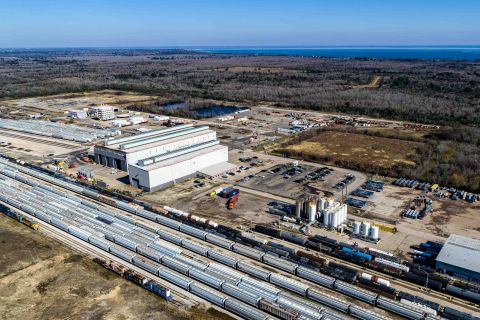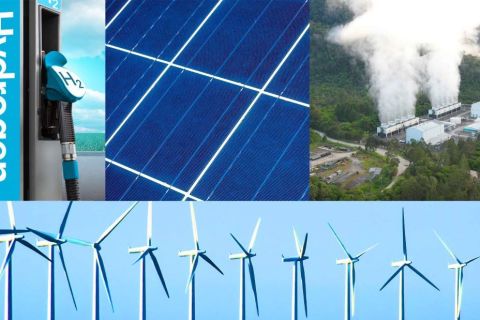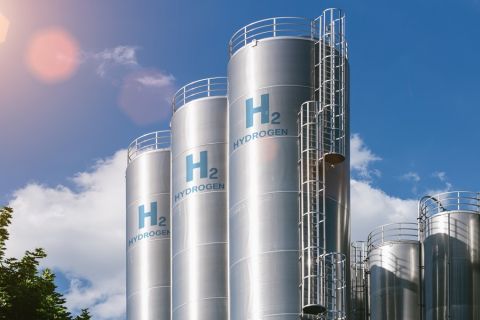Originally discovered in 1993, the Stag oil field, which is on the North West Shelf of Western Australia, has produced more than 58 MMbbl since production began in 1998. The field is a shallow – 680 m (2,231 ft) subsea – highly unconsolidated and highly permeable sandstone. Reservoir depletion, unconsolidated rock, water breakthrough, and sand production have created conditions where infill drilling campaigns have become increasingly problematic in recent years.
On three recent infill wells the intermediate 12¼-in. intervals were drilled and cased using casing-while-drilling (CWD) technology with a rotary steerable system (RSS) and LWD tools. The RSS was used to navigate wellbore congestion, drill designer well paths to avoid incoherencies (a mappable seismic attribute that was found to correlate to hole problems), land the horizontal section, and then drill horizontal tangent sections out to the initial reservoir penetration (liner point).
The CWD applications progressed from a new technology trial, followed by a stretch performance goal, to ultimately being used as a key enabling technology to drill a well that might otherwise be deemed undrillable due to instability issues.
The directional CWD 12¼-in.-hole intervals were drilled using standard premium casing connections from just below the 13?-in. surface casing to the 9?-in. casing point building from 25° inclination to horizontal and holding thereafter. The CWD technique set world records drilling on a mature structure in the M. Australis sandstone formation in the Stag field.
Well construction challenges
The M. Australis sandstone is characterized as a high-permeability glauconitic sandstone oil reservoir. To date, 48 wells have penetrated the reservoir that is overlain by the Muderong Claystone. The conventional technique was to land the intermediate section of the well in the reservoir and drill a horizontal drainhole with an 8½-in. bit. A predrilled liner comprised the lower completion with an electric submersible pump (ESP) for the upper completion.
Issues with water influx and sanding forced a change to running sand screens with inflow control devices (ICDs). However, drilling problems and escalating costs led management to conduct a study to discover a better way to manage these challenges.
The results of the study led to two major modifications in the conventional wisdom. First, it was decided to avoid the water influx by drilling laterally through the overlying Muderong shale until reaching the production zone, then dropping trajectory to the oil-rich target. Second, switching to a modified CaCO3 bridging drill-in fluid was proposed to mitigate total losses while drilling the reservoir section. A particle size distribution analyzer monitored returns, and the dilution rate was adjusted on the fly to maintain desirable mud properties.
Advantages of CWD
Operational difficulties experienced using these modifications encouraged further study. Among the suggestions was CWD. While new to the area, the technique offered many incentives. Eliminating the need to trip pipe for a bit change provided a significant advantage. Other benefits such as eliminating lost time due to sloughing shales, tight hole, bridges, fluid loss, unstable borehole, and stuck pipe were cited. Essentially, the advantages served to derisk the well by eliminating high-risk operations.
Nevertheless, the idea had its detractors. They wondered if the required dogleg severity could be achieved. Could the casing withstand the torque? What if the casing got stuck before total depth was reached? Concerns about maintaining well control and handling a well control situation had to be addressed.
Another key concern was the risk of drilling without a borehole protector at the wellhead housing. The solution was a two-stage wellhead housing with emergency slips and seals that could be inspected for damage after cementing each string. In three jobs no damage was observed.
While rig issues and the drilling plan were being addressed, a geophysical advisor was studying the seismic section where the wells were to be drilled. Incoherencies were observed in the seismic data set that seemed to correlate with drilling problems on offset wells. While there was no clear explanation of the relationship between incoherencies and problems, it was decided to err on the side of prudence and modify the well trajectories to avoid the incoherencies.
Meanwhile, it was suggested to employ a point-the-bit RSS augmented by an in-line mud motor for best trajectory control and hazard avoidance. The RSS and mud motor were specifically selected for operation in conjunction with an underreamer hole-opener. The entire bottomhole assembly (BHA) could be retrieved for bit changes or changing LWD tools if necessary.
The low-speed, high-torque mud motor was specifically selected because it allowed adequate flow rates while maintaining a modest bit speed. By only delivering a 110-rpm to 130-rpm bit speed, the casing rotation could be maximized so that the maximum rpm of 185 rpm at the LWD tools would be seen. The increased rotary speed reduced ECD effects in the casing by openhole annulus and was still well below the allowable fatigue cycles on the casing and its connections.
Buildup rates were planned to stay below 3.5°/30.5 m (100 ft) to avoid fatigue strain on the connections. After modeling on the two most difficult wells, a mixed string was used with premium connections and 47 lb/ft L80 casing on bottom and 53.5 lb/ft P110 casing on top. The third well was able to use 47 lb/ft L80 casing all the way.
A big advantage of the CWD technique is the “plastering effect” of the cuttings and wall cake against the borehole due to the close tolerance of the casing-borehole annulus. The rotating casing seems to smear the mud into place like plaster on a wall. Laboratory studies conducted by others have confirmed that the greatly reduced cutting size distribution has a very positive effect on filtration and losses.
Observances on previous casing-drilled wells have confirmed that the effect results in better loss control and borehole stability. Cuttings-laden mud returns flowing in the tight annulus seem to have enough energy to move the cuttings. A potassium chloride/polymer mud system was ultimately selected over a more inhibitive system as it reduced any balling tendencies, mitigating the risk of RSS housing roll and giving the best CWD results.
Successful application
The CWD technology was proven as a viable solution for drilling through problematic intervals. The technology was used on these applications – in increasing complexity – successfully from a trial to performance/envelope stretching exercise and ultimately as a key enabler. CWD technology is changing the way future Stag oilfield wells are drilled and should be considered for everyday wells in different areas as a viable drilling method.
The success achieved opens the doors for new technologies that can be used either from jackups or floaters. Liner drilling with retrievable RSS BHAs (Multi-Set liner hanger) is being considered as a natural continuation of CWD success. This technology allows the operator to extrapolate the observed benefits of CWD in a deepwater environment.
Acknowledgment
This article was prepared based on SPE 166166, presented at the 2013 SPE Annual Technical Conference and Exhibition held in New Orleans, La., Sept. 30 to Oct. 2, 2013.
Recommended Reading
One Man's Trash? Treasure of RNG Prospects Available for Waste Facilities
2024-02-21 - About 4.4% of current U.S. fossil gas demand could be displaced by RNG from waste, a new Deloitte report shows.
John Cockerill Americas President Talks Hydrogen, Electrolyzers
2024-03-06 - Nicolas de Coignac, president of Americas for John Cockerill, recently spoke with Hart Energy about the company’s role in scaling electrolytic hydrogen in the U.S.
First Solar Gunning for $1B More in 2024 Sales
2024-02-28 - Solar module manufacturer First Solar forecasts 2024 net sales of between $4.4 billion to $4.6 billion, with annual volumes sold ranging from 15.6 gigawatts (GW) to 16.3 GW.
Energy Transition in Motion (Week of March 1, 2024)
2024-03-01 - Here is a look at some of this week’s renewable energy news, including Chevron’s plans for a solar-to-hydrogen facility in California.
Tangled Up in Blue: Few Developers Take FID on Hydrogen Projects
2024-04-03 - SLB, Linde and Energy Impact Partners discuss hydrogen’s future and the role natural gas will play in producing it.





